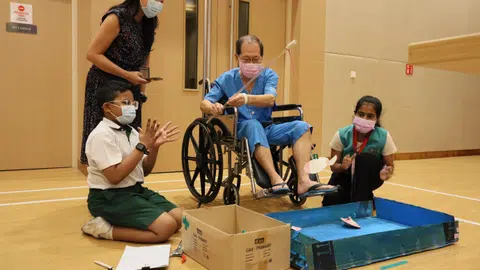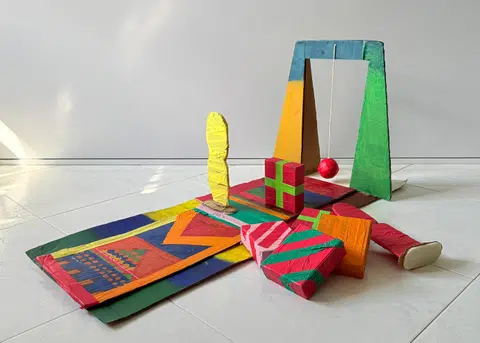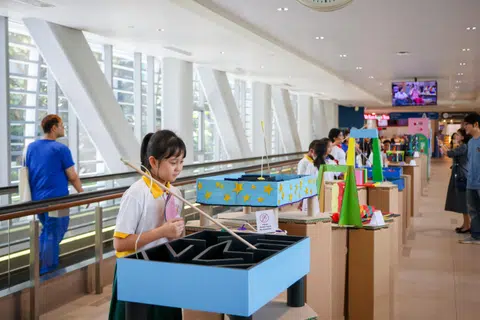Pupils create rehab games for elderly patients at Jurong Community Hospital
Primary school pupils partnered with a hospital to design rehabilitation games.
Cardboard, pipe cleaners and a dash of creativity were all 11-year-old Shahyem Samir needed to invent Fishing Brawl, a game where elderly patients race to hook the most paper fishes in a minute.
"I wanted to create a game where patients can compete and practise their coordination," said Shahyem, who first interacted with seniors when he was in kindergarten and remembered how they liked such games.
He is one of 16 art club pupils from Princess Elizabeth Primary School who recently teamed up with Jurong Community Hospital (JCH) and eco-artists to design a series of rehabilitation games.
The line-up features ring toss, memory challenges, a wrecking ball game to knock down objects, and a magnetic rod to guide coloured balls through a maze.
Of the 15 games the pupils trialled, three were chosen to be refined for regular use at the hospital.
Working closely with occupational therapists, the Primary 5 pupils tailored the games to improve motor skills, coordination and cognitive function.
Two engagement sessions at JCH with 20 elderly patients turned the hospital into a buzzing playground, as patients tried out all 15 games and gave their feedback.
Ms Lilian Lim, head of occupational therapy at JCH, said the patients enjoyed the variety of the games. "In terms of the rehab process, sometimes it can be a bit mundane, and our patients have to do repeated exercises and activities such that they can regain their function," she said.

"The use of games and interesting activities typically improves and increases patients' motivational level," said Ms Lim, adding that the patients become happier during the session.
The patients also enjoyed relating to the pupils, she said, adding that the interaction let them reminisce and have fun with the young ones.
The trial also lets patients give feedback, making them feel involved and able to contribute, which gave them a sense of fulfilment, said Ms Lim.
Another pupil, 11-year-old Tye Ming Xi, created Wrecking Ball, where patients stand behind a table and swing a ball to knock over as many objects as possible.

Kaylie Ang, also 11, designed Catch The Colour, in which patients use a magnetic rod to guide coloured balls through a maze and collect as many as they can in one minute.
Ms Lim said the games were chosen for their ease of use, ability to help improve specific functions like cognitive skills, and adaptability - whether to adjust difficulty level or serve multiple purposes.
The pupils spent months designing, testing and refining their games, taking in feedback from both patients and the eco-artists who ran workshops at their school.
All three pupils said they were proud to see their creations in action.
For Shahyem, it was rewarding to see elderly patients having fun in the hospital, where they do not always get the chance to play. "It was also fun to see them compete," he said.
Shahyem and Ming Xi said the project taught them determination. "Although it took me very long to get to the final product, I persevered, and it was worth it," Ming Xi said.
The three pupils also said they tried their best to keep the games accessible to all, understanding the needs of the patients and putting themselves in their shoes.
For the hospital, the project with Princess Elizabeth Primary School reflects a larger vision of arts in healthcare - to bring joy to patients and also to have more colour in the hospital, compared with just bare walls, said Ms Tan Hwee Ping, head of community relations at Ng Teng Fong General Hospital and JCH.

"Staff feel a lot more energised when they see colours and art in the hospital."
Co-creating the art with patients, staff and the community was also key, Ms Tan said. "Our patients benefited, not just in the final outcome, but also in the whole process of engaging with the kids," she added.
Ms Lim said that beyond cognitive and physical gains, patients also enjoyed emotional and psychological benefits.
"For patients who might be a bit more depressed, sometimes this expression of play and being out of the hospital environment does foster more joy in them, too," she added.
"When they successfully hook the fish, for example, it feeds their self-esteem to know that they are actually mastering something new. They have this sense of achievement and confidence."
During these sessions, patients also started communicating and making friends naturally, she added.
"Play is for all ages," Ms Lim said. "A lot of times, people forget that play is a very important part of everybody's life."
Gabrielle Chan for The Straits Times